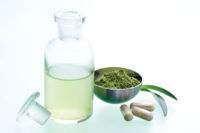Tea May Kill Hospital Pathogen

A joint project between the National Botanic Garden of Wales and the School of Pharmacy and Pharmaceutical Sciences at Cardiff University has collected tea samples from across the globe and is testing its ability to kill the hospital bug.
Clostridium difficile -- C.diff -- is one of the most common hospital-acquired infections in the U.K., and re-infection rates are high, due to its resistance to the antibiotics used to treat it. Scientists are hoping a special compound in tea might provide a potent and viable alternative to conventional medicine.
Professor Les Baillie, of the Welsh School of Pharmacy, said the study, which began in 2008, came about after researchers stumbled upon tea’s ability to kill the deadly bacteria anthrax.
“We had done some preliminary work on tea -- looking at standard breakfast teas mainly -- and found that it kills bacteria,” he said.
“It evolved that clostridium difficile is also vulnerable to tea and, as a gut-based disease, is where we ingest foods like tea. We liked the idea that we could develop a drinkable tea that kills the bug.”
Will McCully has developed the study as part of his PhD thesis to investigate tea’s use as a viable treatment.
He said, “Tea is a hot water infusion of the leaves from the Camellia sinensis plant. It is one of the most widely consumed drinks worldwide, and in the U.K., we drink more cups of tea per head than any other nation.
“There are many different varieties of tea, the most common being black tea and green tea. However, these different varieties are all from the same plant and only differ by the manner in which the plucked leaves are processed.”
For centuries, tea has been widely used for its medical properties, particularly in Chinese medicine.
In recent scientific research, tea has been shown to have antibacterial, anticancer and antiviral properties.
“These properties are thought to be due to a group of antioxidants in tea called polyphenols,” McCully said.
“Since we discovered that tea inhibits the growth of the hospital ‘superbug,' for the last two years we have been collaborating with the National Botanic Garden of Wales to try to discover what components in tea are responsible for its antibacterial activity against clostridium difficile and to understand its mechanisms of action.
“Armed with this knowledge, we will try to modify the growth conditions of a small plantation of Camellia sinensis plants this summer to produce a ‘super tea’ rich in polyphenols and high in antibacterial activity.
“The ultimate aim is to successfully produce a naturally enhanced tea that will be clinically effective against clostridium difficile infection. The idea is to find out if we can we grow a tea that has high levels of antibacterial compounds.
“We obtained 33 single plantation teas from different regions around the world and they were tested against 79 clinical strains of C.diff that arose between 2000 and 2011. We were able to test a cohort of strains to see if our tea had a broad spectrum activity against them all, and they did.”
It was found that green teas were more active than black teas and that the best green tea was still potent at 3% volume in liquid form.
McCully said, “Essentially although green tea and black tea come from the same plant, chemically they are very different.”
Baillie said natural products have been used for thousands of years to treat infectious disease and until the emergence of antibiotics were still widely used in the western world.
He said, “The emergence of multi-drug resistant pathogens has prompted researchers to re-examine the potential of natural products such as honey, hops, tea and bacteriophages as a means of tackling these problem organisms.”
Looking for a reprint of this article?
From high-res PDFs to custom plaques, order your copy today!




